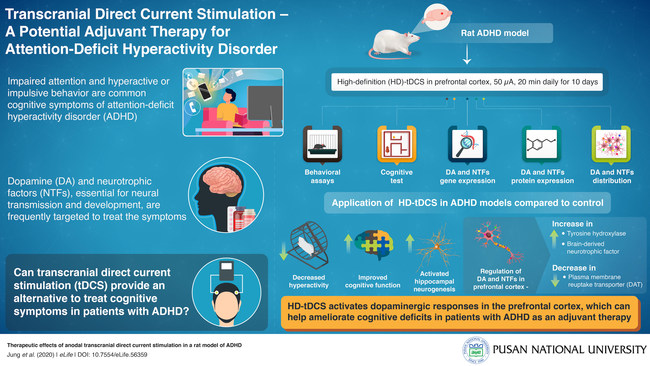BUSAN, Korea, Feb. 11, 2021 /PRNewswire/ — Attention-deficit hyperactivity disorder (ADHD) is a neurological disorder that is highly prevalent in children, and is marked by cognitive symptoms like extreme fidgeting, distraction, and hyperactive and impulsive behaviors that affect their social interactions.

Compromised transmission of brain signals is found to be strongly associated with the development of ADHD. As dopamine is one of the key “neurotransmitters” – chemicals that transmit signals in the brain – involved in behavior and cognition, psychostimulants that can control dopamine are frequently used to treat ADHD. However, some patients respond poorly to this treatment and suffer from adverse effects, leaving scientists on the lookout for a better alternative.
Transcranial direct current stimulation (tDCS) – wherein electrical current is directly applied into the brain – is known for its potential in improving cognitive function with minimal adverse side effects. As ADHD is accompanied by considerable cognitive dysfunction, could tDCS be a potentially therapeutic alternative in affected individuals?
Researchers from Pusan National University, Republic of Korea led by Prof. Byung Tae Choi explored this possibility in a rat model of ADHD using high-definition (HD)-tDCS that stimulates a specific cerebral cortex region. Speaking of its advantages in their study published in eLife, Prof. Choi says, “Our anodal HD-tDCS uses small ring-based electrodes to facilitate cerebral cortex stimulation and target current delivery, thereby overcoming the lack of specificity unlike conventional tDCS.”
They subjected ADHD rat models implanted with an electrode chip to tDCS and compared behavioral changes and cognitive function measured using open field and maze animal tests with those of untreated animals. They found that application of tDCS significantly reduced hyperactivity, and improved memory and cognitive abilities in ADHD rats.
Furthermore, they measured changes in the level of dopaminergic-related factors and neurotropic factors (NTFs), the biomolecules involved in normal brain development and neurotransmission. Since deregulation of dopamine and NTFs has been associated with ADHD pathogenesis, it is likely that tDCS will impact the expression of dopamine and NTFs. Sure enough, they found a significant increase in the expression of NTFs like brain-derived neurotropic factor (BDNF) and decrease in dopaminergic neurotransmission factors such as plasma membrane reuptake transporter (DAT) at the gene and protein level.
Highlighting the applications of their study, Prof Choi remarks, “Anodal HD-tDCS over the prefrontal cortex ameliorates cognitive dysfunction via regulation of DAT and BDNF in dopaminergic pathways, an important target in the clinical manifestation and pathogenesis of ADHD. Therefore, our anodal HD-tDCS represents a potential adjuvant therapy for treating cognitive deficits of ADHD.”
Overall, their findings open avenues for safe and effective treatment of not just ADHD, but a range of other neuropsychiatric disorders.
Reference
Title of original paper: Therapeutic effects of anodal transcranial direct current stimulation in a rat model of ADHD
Journal: eLife
DOI: 10.7554/eLife.56359
Pusan National University Website
Website: https://www.pusan.ac.kr/eng/Main.do
About the author
Prof. Byung-Tae Choi is a professor at the Department of Korean Medical Science, Pusan University and also serves as the director of Graduate Training Program of Korean Medical Therapeutics for Healthy-aging. He has published over 159 papers in his career. His research interests focus on neuroprotection in brain disorders involving apoptosis, cell viability, ERK, and stem cells.
Media contact:
Young-suk Hwang
291233@email4pr.com
+82 51 510-1311
SOURCE Pusan National University

